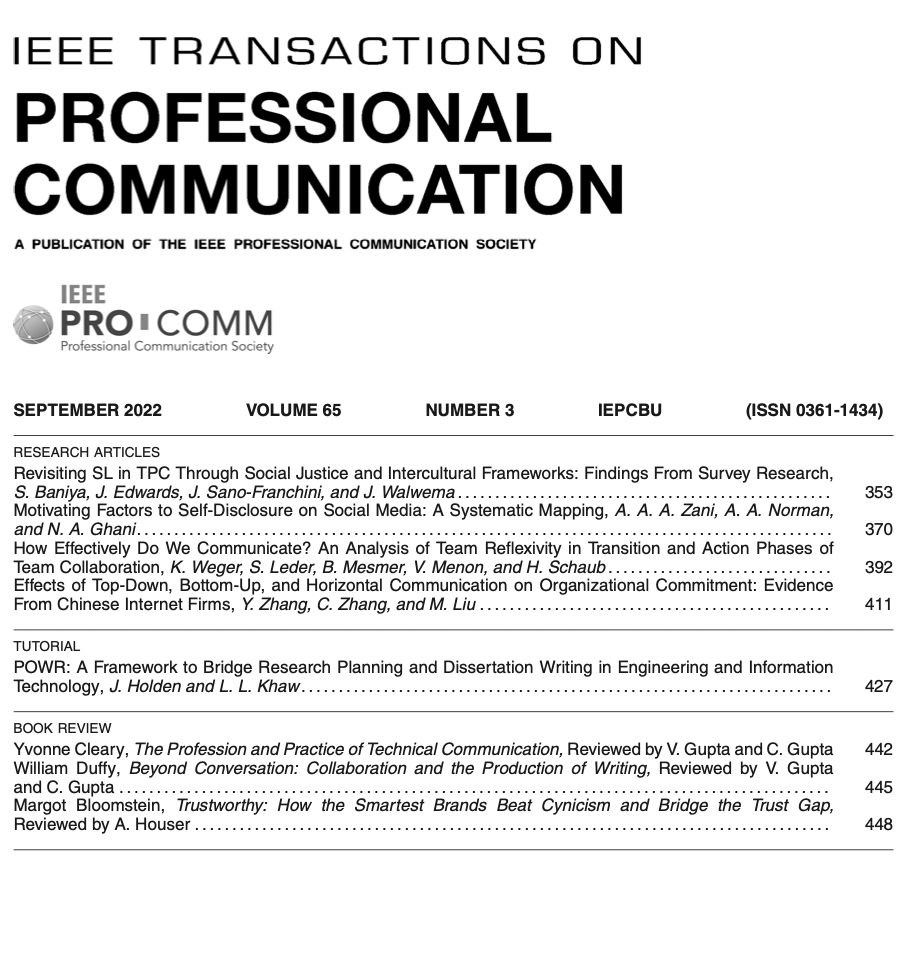The Sept 2022 issue of IEEE Transactions on Professional Communication is Now Available
09 September, 2022
Published on September 21, 2022
Volume 65, Number 3, September 2022

| Research Articles: Revisiting SL in TPC Through Social Justice and Intercultural Frameworks: Findings from Survey Research, by S. Baniya, J. Edwards, J. Sano-Franchini, and J. Walwema This article reports on survey-based research of technical and professional communication (TPC) teachers and administrators, illustrating how these participants implement social justice and intercultural communication pedagogies in service learning (SL). Using purposive sampling, we surveyed 55 TPC teachers and administrators about their experiences with and attitudes toward social justice and intercultural communication in SL. We identify what courses are reported as sites of SL projects as well as participants’ self-reported perceptions about social justice in SL. In addition, we outline four themes related to the application of social justice and intercultural communication theories to SL: activities, constraints, points of resistance, and goals and outcomes. We conclude with recommendations for TPC administrators and programs, and by briefly discussing implications for TPC practitioners and future directions for research. Motivating Factors to Self-Disclosure on Social Media: A Systematic Mapping, by A. A. Ali Zani, A. A. Norman, and N. A. Ghani Self-disclosure on social media can cause some privacy risks, but it benefits users and businesses if adequately managed. We conducted a systematic mapping study that included relevant journal and conference publications. Mapping studies are suitable for structuring a broad research field concerning research questions about content, methods, or trends in the existing publications. We found four categories for social media self-disclosures: discloser-related, audience-related, platform- and affordances-related, and perceived risk- and cost-related. The mapping of available studies helps researchers, academics, and practitioners understand existing self-disclosure motivations and research gaps. In addition, social media stakeholders planning to use social media self-disclosures within their areas of interest can use this study as a starting point to understand what drives social media self-disclosures. How Effectively Do We Communicate? An Analysis of Team Reflexivity in Transition and Action Phases of Team Collaboration, by K. Weger, S. Leder, B. Mesmer, V. Menon, and H. Schaub Communication is the backbone of effective collaboration, yet engineering projects often fail due to poor communication. In this study, we focus on team reflexivity in direct application to engineering project management to identify reflexivity processes that facilitate effective communication. We analyzed collaborative activity among 62 four-person teams in a computer-simulated microworld across two scenarios. Analyses indicated that team reflection promoted discussions about key issues, facilitated frequent process shifts among transition and action phases, and resulted in overall better performance. Our findings demonstrate the importance of team reflexivity interventions in engineering project teams to strategically guide members to improve planning, responding, and quality of attention devoted to long-term outcomes. Effects of Top-Down, Bottom-Up, and Horizontal Communication on Organizational Commitment: Evidence from Chinese Internet Firms, by Y. Zhang, C. Zhang, and M. Liu Internal communication is an important factor shaping employees’ organizational commitment. Practices can be classified into three types according to the direction of information flow: top-down, bottom-up, and horizontal communication. A structural equation model using partial least squares was employed to analyze survey data from 12,817 full-time employees in the Chinese internet sector. The results suggest that top-down, bottom-up, and horizontal communication affect organizational commitment positively and significantly via the mediating routes of employees’ perceived job attractiveness or perceived customer service performance. The study also reveals a fit between employees’ job characteristics (e.g., information-processing demands) and internal communication types to improve organizational commitment. These findings generate theoretical and practical implications for professional communication management. Tutorial: POWR: A Framework to Bridge Research Planning and Dissertation Writing in Engineering and Information Technology, by J. Holden and L. L. Khaw Ph.D. students need a framework to conceptualize their research and a mechanism to transfer it to writing in the required genres. This tutorial centers on sociocognitive and sociocultural planning processes, along with dissertation genre writing. Our two-stage Plan, Organize, Write, Research (POWR) framework proposes a way to link a sociocognitive and sociocultural planning process and the structuring of research communication. POWRa provides a way to conceptualize the iterative planning process underpinning a long-term project, and provides a bridge to POWRb, the more formal genre communication of the project, through the dissertation document. The tutorial provides a framework to articulate a research project in a supervisory and team environment. The framework provides an iterative decision-making structure that is systematic, explicit, and equitable for research project planning and transfer into the writing genre of doctoral dissertations. |

